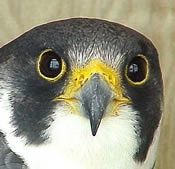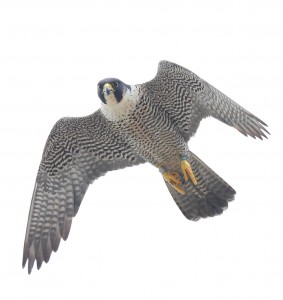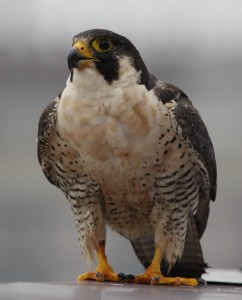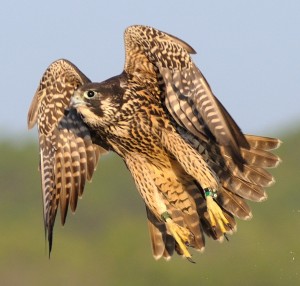PEREGRINE FALCON

Few species of birds have ever been so long esteemed as the peregrine falcon. Since medieval times when valued as a hunting companion of royalty, the peregrine has been recognized for its’ breathtaking beauty and speed. Considered a wanderer, or peregrinator, the aptly named peregrine falcon is a cosmopolitan species with populations found on every continent with the exception of Antarctica. The peregrine suffered dramatic worldwide population declines at the hands of pesticides in the mid-1900’s. Two of the three North American subspecies were nearly decimated and by the early 1960’s all known breeding pairs east of the Mississippi had disappeared. The peregrine was listed as federally endangered in 1970 under the Endangered Species Conservation Act. Beginning in the 1970’s, a national effort was undertaken to recover breeding populations and to restore the species throughout the historic range.
APPEARANCE
The peregrine is a true falcon with a toothed upper mandible, a notched lower mandible, and a circular nostril with a central bony tubercle. Exposed fleshy parts including the cere, eye ring, and feet are bright yellow. Bill is yellow at the base grading to gray and then black toward the tip. Eye color is a deep brown. In all plumages, birds appear hooded due to the dark cap and broad mustache mark.

Adult female falcon breeding on Watts Island, VA. Photo by Bart Paxton.

Adult female falcon breeding in downtown Richmond, VA. Photo by Barton Paxton.
Juvenal plumage is dark brown above with some feathers maintaining buff edges. Breast, belly, and leg feathers have thick brown streaks on a buff background. Transition to adult plumage occurs during the second and third calendar years. Adult plumage on back varies from a steel to a slaty blue with dark barring that becomes more prominent toward the tail. Chin, throat, and breast are plain and vary from a clear white to a tawny buff. Belly, leg feathers, and wing lining have fine black bars.

Juvenile Peregrine Falcon. Photo by Bryan Watts.

Juvenile Peregrine Falcon midflight. Photo by Allen Sklar.
SIZE

Male (left) and larger female (right) peregrine chicks in a nest box. Photo by Bryan Watts.
Peregrine falcons are medium sized raptors approximately the size of crows. As with many raptors, males and females differ substantially in size with females being larger. Males are 38 – 46 cm length, have a wingspan up to 99 cm, and weigh 500 – 800 g. Females are 46 – 55 cm length, have a wingspan of up to 112 cm, and weigh 750 – 1,200 g.
